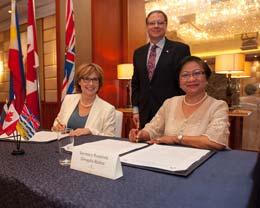Canada wants more Pinoy skilled workers

British Columbia is on the hunt for Filipino welders and pipe-fitters as it anticipates a shortage of such skilled workers to build 10 new non-combat ships for the Canadian Coast Guard.
Thousands of new jobs in the skilled trades were created in British Columbia when the federal government gave the Vancouver Shipyards the $3.3 billion contract last year.
Anticipating a possible shortage of qualified tradesmen, the Canadian Welding Bureau has accredited test centers in the Philippines to screen well-trained welders, reports ABS-CBN news.
“The welders that we are training in Canada right now are not sufficient to fill that vacuum that’s why the Canadian government is looking of hiring temporary workers from outside, and right now, the Philippines is a very favorable place to hire the welders,” said Bob Montes, certification services representative of the Canadian Welding Bureau, according to the website.
Montes added that welders will also be in big demand when construction for the pipeline from Alberta to British Columbia begins.
He said Filipinos have a natural skill for welding and they have a huge plus over others.
“The advantage of the Filipinos is because they can understand and they can read and comprehend standards. When they come here, it’s easy for Canadians to give them instructions. If they cannot follow instructions, it will become a safety issue here,” Montes said.
He added a skilled welder can earn from 50 Canadian dollars (around P2,000) plus per hour.
Currently, there are only three centers that are accredited by the Canadian Welding Bureau: Brilliant Metal Works, Zoie Training Center and Primary Structures Educational Foundation, all based in Cebu.
Those who pass the test here will get a welding card that is valid anywhere in Canada.
With these developments, the Philippine Labor Office is confident that Canada will continue to hire more temporary foreign workers despite charges that the program is stealing jobs away from Canadians.
Meanwhile, Canada has announced it will give $4 million in funding to help nurses get their credential recognition faster.
Filipino Canadian nurse Jessica Celeste welcomed the additional funding for regulatory bodies to speed up assessment and licensing processes.
She said the funding is partly because of the looming shortage of nurses in Nova Scotia, Newfoundland and Ontario in the coming years.
Other provinces like British Columbia are also currently not accepting nurses for permanent residents.
This is why most Pinoy nurses come here to work as live-in caregivers, hoping to apply as registered nurses whey they get their permanent residency.
But a long process awaits them.
“Bago sila makapag-apply sa licensure na ‘yun they have to go through a lot of assessments and those assessments are actually based on the regulatory bodies. They actually check and see if all the qualifications have met their standards of education kasi mataas din ang standard ng British Columbia,” said Celese, steward liaison for South Island of the British Columbia Nurses Union (BCNU).
Many are discouraged because they cannot afford to pay for registration and examination fees.
RJ Celdran worked as a registered nurse in Saskatchewan a few years ago. But when he moved here after going back to the Philippines, Celdran cannot apply for the same job.
“When I checked their website, I came to learn that every province has a different policy, regulations and there are different steps to take. So iba yung Saskatchewan and iba yung dito,” said Celdran.
Philippine Labor Attache, Atty. Bernardino Julve said talks on this issue have started during BC Premier Christy Clark’s visit to Manila in 2012.
They are hoping to follow the Saskatchewan model and make it easier for foreign trained registered nurses to practice in Canada.
Quebec meantime is the only province that has opened applications for nurses.
“Nurses are only allowed to apply via the Quebec program. It’s based again on point system. But if you are going to Quebec of course you have to be adaptable,” said immigration consultant, Natie Sotana.
Millions of Filipinos work overseas sending home billions of dollars every year to the Southeast Asian nation.
Money sent home through banks by Filipinos jumped 7.5% -- the fastest annual growth since January last year -- to $2.063 billion in November from $1.918 billion notched in the same month of 2012, the Filipino central bank said in a statement.
“The steady deployment of overseas Filipino workers remained the key driver of growth in remittance flows for the first 11 months of the year,” the BSP said.
In the breakdown, remittances from land-based workers rose by 5.5% to $15.8 billion while money sent by sea-based workers increased by 8.2% to $4.8 billion.
The primary sources were United States, Saudi Arabia, the United Kingdom, the United Arab Emirates, Singapore, Canada and Japan.
Remittances normally account for a tenth of the country’s gross domestic product.
Leave a comment






